Omega 3
• Omega 3 is the name of a type of fat that is found in oil-rich fish and some plant oils and is also known as ‘n-3‘.
• Omega‐3 and omega‐6 fats are both polyunsaturated fatty acids.
• The main forms of omega‐3 are the “parent” molecule, Alpha Linolenic Acid (ALA), which can be found in a variety of plant based sources such as walnut, hemp, soy, flax and canola oil and the two longer‐chain omega‐3 molecules, docosahexaenoic acid (DHA) and eicosapentaenoic acid (EPA).
• DHA and EPA are “essential” fatty acids, which means that our bodies can’t
synthesise them and we need to consume them in our foods such as fish, nut and plant-based oils, such as canola oil and sunflower oils.

• A small percentage of the ALA consumed can be converted into DHA and EPA in our bodies but the richest source of these essential fatty acids is seafood.
Long-chain omega 3 fatty acids are needed for normal growth and development in the body, and are also required to maintain cardiovascular health and brain function. Therefore, everybody should be aiming to consume enough regularly to prevent deficiencies and to be healthy.
Since omega 3 essential fatty acids are needed for the membranes of all body cells their role in health is wide reaching: encompassing not only healthy heart and brain function but also playing an important role in the normal function of the eyes, the nervous system, the kidney, and the liver, in fact all body systems. Other functions also include the contraction of muscles and the dilation/constriction of blood vessels, blood clotting, and inflammatory processes.
Only consuming plant sources of essential fatty acids (i.e. ALA) means that the conversion process to the longer chain fats, DHA and EPA, will not be efficient therefore possibly requiring an additional source of omega 3 to maintain optimum intakes.
The main oil-rich fish available are: salmon, trout, mackerel, sardines, pilchards, herring, kipper, eel and whitebait, fresh, frozen or tinned. Tuna is only counted as an oily fish if it is fresh or frozen, as the tinned variety does have some oils, but not as much as the fresh one.
What are the types of omega-3 fatty acids?
ALA – ALA, or alpha-linolenic acid, is an 18-carbon chain and three cis double bonds. The first double bond is located in the n-3 position or at the omega end of the fatty acid. Thus, ALA is considered a polyunsaturated n-3 (omega-3) fatty acid.
EPA – EPA or eicosapentaenoic acid contains a 20-carbon chain and five cis double bonds; the first double bond is located at the third carbon from the omega end. Therefore, EPA also is considered an omega-3 fatty acid.
DHA – DHA or docosahexaenoic acid is a 22-carbon chain with six cis double bonds; the first double bond is located at the third carbon from the omega end of the fatty acid. Therefore, DHA is also considered an omega-3 fatty acid.
What are the sources of these omega-3 fatty acids?
ALA – Flaxseed, canola and soybean oils, and walnuts
EPA and DHA – Fatty fishes such as mackerel, herring, salmon, tuna, and trout
Omega 3 Health Benefits
- Builds better brain functioning. Pregnant and nursing mothers can have a great impact on the intelligence and happiness of their babies by supplementing with fish oil. For adults, omega 3 improves memory, recall, reasoning and focus. You'll swear you're getting younger and smarter.
- Decreases pain and inflammation. Omega 3 fatty acids, particularly EPA, have a very positive effect on your inflammatory response. Through several mechanisms, they regulate your body's inflammation cycle, which prevents and relieves painful conditions like arthritis, allergy rhinitis, prostatitis, cystitis and anything else with an "itis" ending.
- Improves cardiovascular health. Omega 3 fatty acids have also been proven to work wonders for your heart and the miles and miles of arteries and veins that make up your cardiovascular system. They help lower cholesterol, triglycerides, bad LDLs and blood pressure, while at the same time increasing good HDL cholesterol. This adds years to your life expectancy. Omega 3 with EPA and DPA is your best defence.
- Reduces heart attack and strokes. When plaque builds up on arterial walls and then breaks loose, it causes a thrombosis, which is a fancy way of saying blood clot. If a clot gets stuck in the brain, it causes a stroke and when it plugs an artery, it causes a heart attack. Research shows omega 3 fatty acids break up clots before they can cause any damage.
- Reduces depression and psychosis. Making you smarter is not all omega-3 does for your brain. Psychiatry department researchers at the University of Sheffield, along with many other research studies, found that omega 3 fish oil supplements "alleviate" the symptoms of depression, bipolar and psychosis
- Increases both male and female fertility. Studies show that infertility is directly related to the amount of fish oil you consume. Fish oil balances hormones, improves hormonal levels and increases blood flow to the uterus. The more Omega 3 fatty acids you get the greater your odds of conceiving.
- Improves all around pregnancy health. Omega 3 fish oil has been shown to reduce the danger of pregnancy preeclampsia (high blood pressure), premature birth and postpartum depression. Fish oil fatty acids also facilitate a healthy placental blood flow and the efficient exchange of nutrients and oxygen between mother and baby and greatly contributes to proper brain development, increasing the child's intelligence.
- Lowers incidence of childhood disorders. Just to show how fish oil fatty acids leave nobody out, studies show that children (and adults) with ADD and ADHD experience a greatly improved quality of life. And those with dyslexia, dyspraxia and compulsive disorders have gotten a new lease on life thanks to omega 3 oils.
- Decreases chances of osteoporosis. Having high levels of fish oil fatty acids has been shown to lower the risk of osteoporosis, which is an especially high for women after menopause.
- Reduces Breast, Colon and Prostate Cancer. And finally, omega 3 fish oil has been shown to help prevent three of the most common forms of cancer - breast, colon and prostate. Science tells us that omega 3s accomplish these in three ways. They stop the alteration from a normal healthy cell to a cancerous mass, inhibiting unwanted cellular growth and causing apoptosis, or cellular death, of cancer cells.
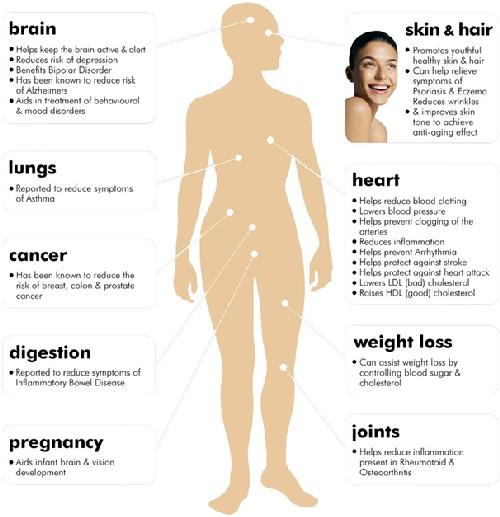
Omega 3 Foods
• Grains
• Spirulina
• Brazil Nuts
• Hempseed Oil
• Mustard Seeds
• Pumpkin Seeds
• Chia Seed Oil
• Wheat Germ Oil
• Canola Oil (Rapeseed)
• Green Leafy Vegetables
• Raw Walnuts & Walnut Oil
• Flaxseeds or Flaxseed Oil
About Health
Human body structure
Human beings are arguably the most complex organisms on this planet. Imagine billions of microscopic parts, each with its own identity, working together in an organized manner for the benefit of the total being. The human body is a single structure but it is made up of billions of smaller structures of four major kinds:
Cells
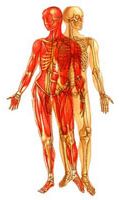 Cells have long been recognized as the simplest units of living matter that can maintain life and reproduce themselves. The human body, which is made up of numerous cells, begins as a single, newly fertilized cell.
Cells have long been recognized as the simplest units of living matter that can maintain life and reproduce themselves. The human body, which is made up of numerous cells, begins as a single, newly fertilized cell.
Tissues
Tissues are somewhat more complex units than cells. By definition, a tissue is an organization of a great many similar cells with varying amounts and kinds of nonliving, intercellular substance between them.
Organs
Organs are more complex units than tissues. An organ is an organization of several different kinds of tissues so arranged that together they can perform a special function. For example, the stomach is an organization of muscle, connective, epithelial, and nervous tissues. Muscle and connective tissues form its wall, epithelial and connective tissues form its lining, and nervous tissue extends throughout both its wall and its lining.
Systems
Systems are the most complex of the component units of the human body. A system is an organization of varying numbers and kinds of organs so arranged that together they can perform complex functions for the body. Ten major systems compose the human body:
• Skeletal
• Muscular
• Nervous
• Endocrine
• Cardiovascular
• Lymphatic
• Respiratory
• Digestive
• Urinary
• Reproductive
• Integumentary System (Skin)
Fertility

Getting to know your cycle is key to understanding your fertility. You need to appreciate what is happening to your body at every stage of the month (i.e. based on a 28 day cycle, what is happening during week one, week two,week three, and week four so that you can interpret signs and work with your natural rhythms to enhance your fertility.
Every aspect of your cycle is equally important. Your menstrual flow is a good indicator of your general overall health and fertility. Women today do not talk with each other as much about their cycle, so, more and more women have an understanding of what is 'normal'. Now that you want to concieve, it is time to get involved, talk about it, learn about it, and feel it like never before. Always remember that what is normal for some is not for others. Volume, colour, length, etc. can vary from woman to woman. If you decide to visit a Traditional Chinese Medicine practitioner to increase your fertility, you will be asked questions about every little sign and symptom that is involved in your cycle.
The Ovarian-Hypothalamus-Pituitary female sexual hormonal axis. If this regulatory system is balanced the woman will feel very little changes throughout her cycle. Most women have some kind of imbalance, therefore they do feel the changes in their cycle, although, these are good ways to get to know what is going on, and aids in the process of rebalancing. 10-15% of miscarriages happen due to hormonal imbalances. Many infertility problems are due to hormonal ovulatory disorder. It makes good sense to get to know this part of you and start balancing it today.
Collagen
What is collagen?
Collagen is a group of naturally occurring proteins.
In nature, it is found exclusively in animals, especially in the flesh and connective tissues of mammals. It is the main component of connective tissue, and is the most abundant protein in mammals, making up about 25% to 35% of the whole-body protein content.
Collagen, in the form of elongated fibrils, is mostly found in fibrous tissues such as tendon, ligament and skin, and is also abundant in cornea, cartilage, bone, blood vessels, the gut, and intervertebral disc.
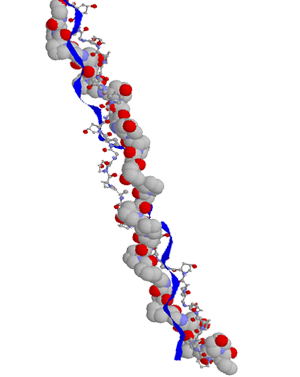 In muscle tissue it serves as a major component of endomysium. Collagen constitutes 1% to 2% of muscle tissue, and accounts for 6% of the weight of strong, tedious muscles. Gelatin, which is used in food and industry, is collagen that has been irreversibly hydrolyzed.
In muscle tissue it serves as a major component of endomysium. Collagen constitutes 1% to 2% of muscle tissue, and accounts for 6% of the weight of strong, tedious muscles. Gelatin, which is used in food and industry, is collagen that has been irreversibly hydrolyzed.
Collagen has great tensile strength and functions in a manner that is very different from many other types of proteins. For example, it can be found both inside and outside of cells. Collagen fibres are important in contributing to the external structure of cells. However, they are present on the inside of some cells as well.
Collagen works hand-in-hand with elastin in supporting the body’s tissues. Basically, it gives body tissues form and provides firmness and strength; elastin gives the same body tissues much need flexibility. This combination of collagen and elastin is very important in many parts of the body, including, but not limited to, the lungs, bones, and tendons. Even the blood vessels rely on both collagen and elastin.
Often, collagen is discussed in relation to the skin. It works with keratin to provide the skin with strength, flexibility, and resilience. As people age, however, collagen degradation occurs, leading to wrinkles. As such, it is an important substance for those looking for ways to fight the visible effects of aging on the skin. Some skincare professionals actually advise people on ways to stimulate the production of collagen in skin cells.
In addition to being so important in the body, collagen also has many medical uses. It is used in some cosmetic surgery procedures and is sold as a supplement created for joint mobility. It is even used in treating and managing serious burns. For this purpose, it is used in creating man-made skin substitutes.
Since collagens are so important within the body, it stands to reason that collagen deficiencies can be problematic. In fact, there are some genetic diseases that are associated with collagen deficiencies. For example, osteogenesis imperfecta, commonly referred to as brittle bone disease, results from a significantly decreased level of collagen. It can also result from the presence of collagen that is of lower quality than normal.
Types of Collagen
A variety of types of collagen exist in varying quantities in almost all of our organs. When using collagen to enhance the appearances of our skin, we must thus take into consideration not only the amount, but also the type of collagen we choose.
|
Important Types of Collagen
|
|
|
Type I |
The most prevalent type, located in our tendons, bones, skin, and other tissues, particularly scars. |
|
Types II, IX, X & XI |
Merely cartilage, located in various places throughout our bodies. |
|
Type III |
Found in quickly-growing tissue, such as that found in wounds in the early stages of repair, and is often replaced later on by the stronger and tougher Type I collagen. |
|
Type IV |
The filtration membrane of our capillaries, known as basal lamina. |
|
Types V and VI |
Similar to Type I, and generally are not found without it, providing support to normal Type I collagen functions. |
|
Type VII |
Known as epithelia and it lines various tracts of our body, such as the GI and urinary tracts. |
|
Type VIII |
Lines our blood vessels. |
|
Type XII |
Interacts with Types I and III collagen, and can always be found alongside them. |
Types I and III collagen are the most prevalent in our skin, controlling most of our skin’s mechanical properties. Though other types of collagen are less abundant in our skin, and often play a less clear, more supportive role to types I and III collagen, each type serves an important function in the maintenance of our skin.
Uses of Collagen
Collagen is one of the long, fibrous structural proteins whose functions are quite different from those of globular proteins such as enzymes.
Tough bundles of collagen called ''collagen fibres’' are a major component of the extracellular matrix that supports most tissues and gives cells structure from the outside, but collagen is also found inside certain cells. As you age, your body is less able to manufacture a sufficient amount of collagen. Collagen can help maintain your body's repair process.
- IMPROVE CIRCULATION
Collagen can strengthen blood vessels and improve their elasticity. Collagen fortifies your blood vessels to improve circulation throughout the body. Blood and nutrients are delivered to your skin, resulting in healthy, radiant and youthful-looking skin.
- PROMOTE HEALING OF INJURIES
Collagen is needed to repair and rebuild connective tissue to encourage strong muscles, skin and joints. Collagen also strengthens the structure of bones, tendons, cartilage and ligaments. Collagen can encourage muscle mass to regenerate and help athletes recover from sports-related injuries faster.
- RELEIVE ARTHRITIS PAIN
Arthritis is an inflammation in the joints that can cause limited and painful mobility in your hand, arm, shoulder, hip and knee joints. Collagen may increase your joint mobility and reduce arthritis pain.
Collagen helps to keep joints fluid and mobile, but the protein gradually disappears from joints as you age. Taking collagen supplements may help treat joint pain associated with arthritis or aging. Increased levels of collagen could improve your joint's mobility while reducing the pain associated with joint movement.
- REDUCE APPEARANCE OF CELLULITE
Cellulite occurs when fatty tissue pushes upward through fibers into the upper layer of skin. The result is a dimpled appearance of the skin.
Collagen work from the inside of your body to reduce the appearance of cellulite. Collagen promotes your body to rebuild and repair the fibers that cause cellulite to appear.
- REDUCE WRINKLES
As collagen depletes, wrinkles and lines form in those places where the skin moves most--such as joints, forehead and lips. Wrinkles and skin blemishes benefit the most from collagen. Aging is the main cause of wrinkles. However, environment, pollutants and rays from the sun all contribute. Regularly taking collagen encourages your skin to become soft and supple.
- IMPROVE HAIR
Collagen is a major component in hair growth, because it fights off free radicals that can affect your hair's texture, growth and thickness. Restoring collagen in the hair shaft can improve hair growth. Collagen strengthen hair and increase the diameter of individual hairs, giving your hair an overall fuller appearance.
- SCAR TREATMENTS
Collagen injections are sometimes used in a treatment called "tissue fillers." These injections place a pocket of collagen underneath a depressed scar that may result from acne.
This raises the depressed skin up to the same level as the rest of your skin, minimizing or eliminating the appearance of the scar. The downside to this benefit of collagen is the temporary nature of tissue fillers—the collagen's effect will wear off after six months.
Collagen injections are sometimes used in a simple lip-plumping procedure. Contrary to the claims made by some topical skin products, though, collagen is not beneficial when applied to the skin—the molecule is too large to penetrate the selective membrane of your epidermis.
- NUTRITIONAL SUPPLEMENT
Because collagen is a protein, it is made up of different amino acids. These small acid chains are strung together in various sequences to form all proteins necessary to your body's health.
Collagen contains eight of the nine amino acids critical to your body's health—from these amino acids, your body can form all proteins essential to your functioning.
There are 20 amino acids in total, but not all are necessary for your health. Because of this protein benefit, collagen is sometimes featured in bodybuilding or muscle-gain supplements to give your muscles the fuel needed to grow in mass.

Other Uses
Gelatin is produced from collagen and is used in many industries. The most common use of gelatin is in food. Gelatin is used in photographic film and to bind the abrasive particles and the paper in sandpaper. Because it is readily accepted by the body, gelatin is often used in pharmaceutical production.
Tips
Gelatin is the most pure protein available and contains all the amino acids needed by body cells and tissues.
Add gelatin to the diet to improve the condition of hair and nails.
Bra Size and Breast Cancer
Breast Cancer Linked with Bra Size
Breast cancer is a leading cancer among women accounting for one-third of all cancers. Increasingly, age group affected by breast cancer is becoming younger. Forty-eight per cent of incidences are in between 25-50 years of age.
Researchers with a commercial DNA company have linked a larger breast size with seven genetic factors that raise the risk for developing breast cancer.
A study of 16,000 women found genetic mutations associated with breast size were also linked to the disease.
Dr Nicholas Eriksson of the California-based genetics firm 23andMe said it was the first substantial link between breast size and cancer, but added much more research was needed before it could be considered concrete.
but added much more research was needed before it could be considered concrete.
He said: ‘Our results identify genetic variants that have an effect on both breast cancer and natural variation in breast size.
‘While the precise relationships between breast size, density, obesity and breast cancer remain difficult to untangle, understanding the biology . . . may aid in the development of novel screening tools.’
He said one of the three mutations regulates the activity of the female sex hormone oestrogen, which can trigger the growth of both breasts and tumours.
While research has linked breast density – the amount of non-fat tissue – to an increased risk of cancer, there has been little evidence of a link with breast size before.
Another is located in a region of a woman’s genome that often shows abnormalities in those with certain types of breast cancer.
The link was seen regardless of the women’s age, pregnancy and breastfeeding history and genetic ancestry, according to the study published in the journal BMC Medical Genetics.
Little is known about the biology of breast size, which scientists believe is only half hereditary, but high oestrogen levels are known to be a risk factor for breast cancer.
There are many different forms of breast cancer, which scientists believe could be treated as ten different illnesses. Weight, alcohol consumption and a strong family history are all risk factors.
A 2006 study by the Harvard School of Public Health on 90,000 pre-menopausal subjects found larger breast size in slim young women gave them a higher risk of breast cancer in later life.
Those with a body mass index of 25 or less and a bra size of D or larger had a significantly higher risk of breast cancer than those of the same weight with a cup size A or smaller, they found.
However, the study’s lead author, Karin Michels, said the findings did not mean those with small breasts could assume they were safe and urged all women to go for breast cancer screening.
Click here to Find More about "Tips For Preventing Breast Cancer"
Myasthenia-gravis (MG)
What is Myasthenia-Gravis(MG)?
Myasthenia Gravis (pronounced My-as-theen-ee-a Grav-us) comes from the Greek and Latin words meaning "grave muscular weakness”. Myasthenia Gravis (MG) is a neuromuscular autoimmune disease that affects the use of muscles - normal communication between the nerve and the muscle is interrupted, leaving the muscle weak and fatigued.
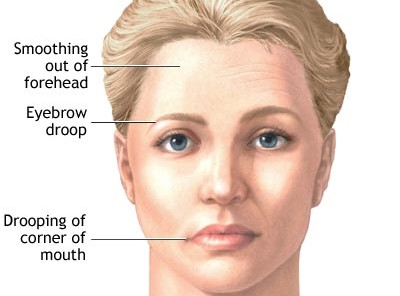 The hallmark of myasthenia gravis is muscle weakness that increases during periods of activity and improves after periods of rest. Certain muscles such as those that control eye and eyelid movement, facial expression, chewing, talking, and swallowing are often, but not always, involved in the disorder. The muscles that control breathing and neck and limb movements may also be affected.
The hallmark of myasthenia gravis is muscle weakness that increases during periods of activity and improves after periods of rest. Certain muscles such as those that control eye and eyelid movement, facial expression, chewing, talking, and swallowing are often, but not always, involved in the disorder. The muscles that control breathing and neck and limb movements may also be affected.
Myasthenia Gravis occurs in all races, both genders, and at any age. MG is not thought to be directly inherited nor is it contagious. It does occasionally occur in more than one member of the same family.
The voluntary muscles of the entire body are controlled by nerve impulses that arise in the brain. These nerve impulses travel down the nerves to the place where the nerves meet the muscle fibers. Nerve fibres do not actually connect with muscle fibres. There is a space between the nerve ending and muscle fibre; this space is called the neuromuscular junction.
When the nerve impulse originating in the brain arrives at the nerve ending, it releases a chemical called acetylcholine. Acetylcholine travels across the space to the muscle fibre side of the neuromuscular junction where it attaches to many receptor sites. The muscle contracts when enough of the receptor sites have been activated by the acetylcholine.
In MG, there can be as much as an 80% reduction in the number of these receptor sites. The reduction in the number of receptor sites is caused by an antibody that destroys or blocks the receptor site.
Antibodies are proteins that play an important role in the immune system. They are normally directed at foreign proteins called antigens that attack the body. Such foreign proteins include bacteria and viruses. Antibodies help the body to protect itself from these foreign proteins.
For reasons not well understood, the immune system of the person with MG makes antibodies against the receptor sites of the neuromuscular junction. Abnormal antibodies can be measured in the blood of many people with MG.
The antibodies destroy the receptor sites more rapidly than the body can replace them. Muscle weakness occurs when acetylcholine cannot activate enough receptor sites at the neuromuscular junction.
Symptoms of Myasthenia-Gravis (MG)
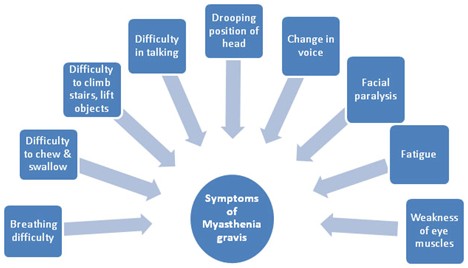
• Difficulty in Breathing; due to weakening of chest wall muscles
• Difficulty to chew and swallow
• Difficulty in climbing stairs, lifting objects
• Difficulty in talking
• Sagging head position
• Facial paralysis
• Fatigue
• Hoarseness or changing voice
• Weakness of the eye muscles causes Double vision and drooping of eyelids
Myasthenia Gravis Causes
Myasthenia Gravis (MG) is all about muscles failing to contract.
Every time your body moves, whether you're walking, talking or breathing, a muscle contracts. There are three general types of muscles
Omega 6
OMEGA‐6
Omega-6 fatty acids are considered essential fatty acids: They are necessary for human health but the body can' t make them -- you have to get them through food. Along with omega-3 fatty acids, omega-6 fatty acids play a crucial role in brain function, as well as normal growth and development. Also known as polyunsaturated fatty acids (PUFAs), they help stimulate skin and hair growth, maintain bone health, regulate metabolism, and maintain the reproductive system.
There are several different types of omega-6 fatty acids, and not all promote inflammation. Most omega-6 fatty acids in the diet come from vegetable oils, such as linoleic acid (LA). Be careful not to confuse this with alpha-linolenic acid (ALA), an omega-3 fatty acid. Linoleic acid is converted to gamma-linolenic acid (GLA) in the body. It is then further broken down to arachidonic acid (AA). GLA is found in several plant based oils, including evening primrose oil (EPO), borage oil, and black currant seed oil.
GLA may actually reduce inflammation. Much of the GLA taken as a supplement is converted to a substance called DGLA that fights inflammation. Having enough of certain nutrients in the body (including magnesium, zinc, and vitamins C, B3, and B6) helps promote the conversion of GLA to DGLA.
Fish oil
What is Fish oil
Fish oil is derived from the tissues of oily fish and is a source of omega-3 (EPA) Eicosapentaenoic acid and (DHA) Docosahexaenoic acid essential fatty acids. These fats are considered 'essential' because they cannot be synthesised by the body and must be supplied through the diet or via supplementation.
What is the difference between omega-3 and fish oil?
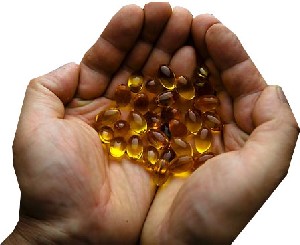 Omega-3 is a component of fish oil. The omega-3 fatty acids found in fish oil are Eicosapentaenoic Acid (EPA) and Docosahexaenoic Acid (DHA). It is the EPA+DHA content of fish oil which provide many of its therapeutic benefits. While omega-3 can be found in foods such as linseeds and wheat-germ, combined omega-3 fatty acids eicosapentaenoic acid and docosahexaenoic acid are available in large amounts in deep-sea cold water oily fish such as salmon, anchovies, mackerel and sardines.
Omega-3 is a component of fish oil. The omega-3 fatty acids found in fish oil are Eicosapentaenoic Acid (EPA) and Docosahexaenoic Acid (DHA). It is the EPA+DHA content of fish oil which provide many of its therapeutic benefits. While omega-3 can be found in foods such as linseeds and wheat-germ, combined omega-3 fatty acids eicosapentaenoic acid and docosahexaenoic acid are available in large amounts in deep-sea cold water oily fish such as salmon, anchovies, mackerel and sardines.
Grams of omega-3 fatty acids per 3oz (85g) serving of popular fish
| Tuna (canned, light) | 0.17-0.24 |
| Tuna | 0.21–1.1 |
| Tilefish | 0.90 |
| Swordfish | 0.97 |
| Shark | 0.83 |
| Salmon | 1.1–1.9 |
| Red snapper | 0.29 |
| Pollock | 0.45 |
| Orange roughy | 0.028 |
| Mahi mahi | 0.13 |
| King mackerel | 0.36 |
| Halibut | 0.60–1.12 |
| Grouper | 0.23 |
| Flounder | 0.48 |
| Cod | 0.15–0.24 |
| Catfish | 0.22–0.3 |
Types of Omega fatty Acids
1. Omega-3 fatty acids are found in both plant and animals but the most concentrated dietary source of combined omega-3s EPA and DHA is fish oil from cold-water fish, such as salmon, tuna, sardines and mackerel.
2. Omega-6 fatty acids obtained from the diet such as linoleic acid (LA) and gamma-linoleic acid (GLA) come from vegetable oils.Omega-6 fatty acids are important for the health of our cell membranes, and may be recommended for conditions of the skin including dry skin and eczema.
3. Omega-9 fats are a class of mono-unsaturated fats and are found in vegetable oils such as olive oil.
Health Benefits of Fish Oil
• Prevent sudden cardiac death (50% risk reduction).
• Prevent stroke (40-50% risk reduction).
• Prevent irregular heartbeat.
• Prevent some forms of cancer (e.g. Breast Cancer & Colon Cancer).
• Reduce craving for fatty foods. Fish oil may help in weight regulation.
• Prevent age-related prostate enlargement in males.
• Prevent and treat Major Depression, Schizophrenia, Bipolar Disorder, ADHD and Anger/Aggression. Fish oil also helps treat Huntington's Disease.
• Prevent Alzheimer's Disease.
• Prevent and treat Rheumatoid Arthritis, Systemic Lupus, Inflammatory Bowel Disease and other inflammatory conditions.
• Improve skin, hair and nail health.
• Prevent diabetes.
• Preserve eyesight decline associated with aging. Fish oil also help to reduce eye dryness.
Fats that control our Health
Backbone of all Fats
Three billion years ago, the only living things on the planet were algae, which consisted of a single membrane composed primarily of fat. But the membranes formed by algae-derived fats far from static; they dance a rhythm controlled by the fluidity within the fat molecule itself. That fluidity is governed by the number of double bonds in the fat molecule.
Double bonds in fats result when hydrogen atoms have been extracted from the carbon-to-carbon bonds that are the backbone of all fats. This extraction is done in a very specific way to enzymes so that each double (called a cis double bond) forms a kink in the molecular structure of the fat as shown below

The more unsaturated a fat molecule is, the more double bonds it has, and the more fluidity it imparts to the membrane. This fluidity is the key to understanding why algae-derived fats made us smart.
About 550 million years ago, when there was an explosion in biological diversity as multicell organisms were starting to evolve from single-cell algae. These new organisms had to develop a communication system so their specialized cells. Another involved the use of hormones.
THE STRUCTURE OF FATS
Depending on the function of a particular cell, your body needs specific types of fats to keep the cell membranes in their appropriate fluidity zone. For example the cells that surround the nerves in your brain need to be very rigid because they provide insulation to maintain the fidelity of the electronic signals. On the other hand, the cells in the retina of the eye have to be extremely fluid to allow visible information to pass into the brain.
Fats can be categorized by their fluidity; they are either
* saturated (solid at room temperature),
* monounsaturated (liquid at room temperature, but cloudy in a refrigerator), or
* Polyunsaturated (liquid in a refrigerator).
Type of Unsaturated Fats in Food
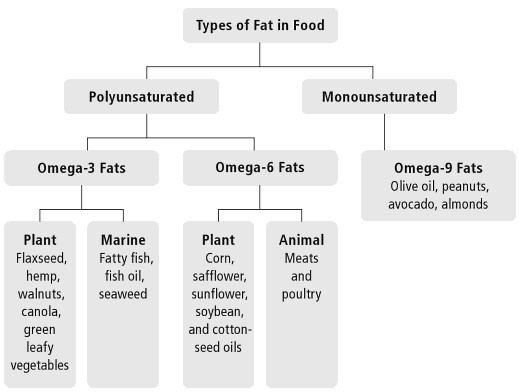
The number of double bonds contained within the fatty acid determines these designations. The more double bonds the fat has, the more fluid (unsaturated) it is. However, the more unsaturated a fat is the more prone it is to be attacked by free radicals, which causes rancidity. Since fish oils contain high levels of polyunsaturated fats, they are quite likely to become rancid.
The first hormones developed by living organisms were known as eicosanoids, and they used fats in cell membranes as their building blocks. These eicosanoids don’t use just any type of fat for their synthesis; they require the long chain highly unsaturated (polyunsaturated) fat found only in algae-derived fats. These were the same fats that made us smart 150,000 years ago, and the eicosanoids that are derived from those fats control out health today.
Do you ever wonder why fish gets a fishy smell after a day or two in your refrigerator? That’s due to its high polyunsaturated fats, which are becoming oxidized.
Within the classification of polyunsaturated fats, there is one further subdivision: omega-3 and omega-6 fats. This distinction has to do with the position of the double bonds in the fat, which determines its three-dimensional structure. This ultimately determines the type of eicosanoids that can be made from fats.
Furthermore, the length of the polyunsaturated fatty acid is critically important, because only the longer chain polyunsaturated fatty acids (20carbon atoms) have the number of double bonds that can provide the fluidity necessary for cells in the retina to transmit visual images to the brain, for never synapses to transfer information throughout the brain, and for the brain’s mitochondria to produce optimal amounts of energy.
In addition, only the long chain polyunsaturated fats (both omega-6 and omega-3) can be used in the manufacture of eicosanoids, which are the keys that ultimately control human health.
Molecular structure of long-chain omega-3 and omega-6
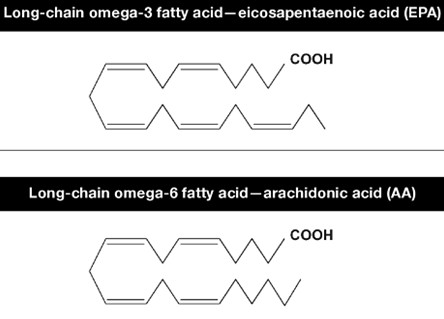
Fats can be synthesised either “good” or “bad” eicosanoids. Long-chain omega-3 fatty acids (found in fish oil) are the building blocks necessary to help manufacture “good” eicosanoids. On the flip side , long-chain omega-6 fatty acids (found in high concentration in vegetable oils) are the building blocks used to manufacture “bad” eicosanoids. The balance of “good” and “bad” eicosanoids will be the primary factor determining your physical and mental health.
Fish oils are rich in long-chain omega-3 fats. Long chain omega-3 fats called eicosapentaenoic acid (EPA) is the key fat for health, whereas docosahexaenoic acid (DHA) is the key fat for the brain. Fish oil is rich in both.
Emotions and illness
Emotions are considered a form of energy that play an integral role in the development of health or illness.
TCM has traditionally viewed the emotions are one of the primary cause of disease. this is in direct contrast to the reductionist viewpoint of western medicine, which has fragmented the human being and separated the psyche from the physical body
Western Medicine has traditionally viewed the emotions as the secondary factors to the cause of disease.
A person suffering from ulcers sees a gastroenterologist and receives medication for his pain, but the stress that may be the cause of his problem is not addressed.

In contrast, Oriental medicine recognizes the innate connection between the mind, body and the emotions.
Emotions are not only a source of disease but can also be a result of illness
Traditional Chinese medicine acknowledges seven emotions. Each of the major organs is affected by and connected with a particular emotion that affects the life energy in a particular way.
The seven emotions are:
Anger - which affects the Liver
Melancholy - which affects the Lungs
Joy or Overexcitement - which affects the Kidneys
Worry and Excessive Thinking - which affects the Spleen and the Lungs
Shock - which affects the Kidneys and the Heart
It is important to note that, under normal conditions, emotions are not a cause of disease. Since energy is inherently neutral, the emotional energies that can be misdirected toward illness can also be harnesses for positive growth and development.
